Protozoa are unicellular eukaryotic microorganisms. Although they are difficult to classify due to their abundance and diversity (more than 50,000 have been described) the most common classification is according to their mechanism of motility. Therefore, there are four subcategories: amoebae, flagellates, ciliates and sporozoan. Protozoa are also defined as ubiquitous, that is to say, they can be found in almost every kind of environment, mainly in moist and watery habitats. They can live as free entities or in association with other species. This symbiotic relationship can be commensalism, mutualism or parasitism.
Plasmodium is a genus of parasitic protozoans of the sporozoa subclass coccidian. Among all plasmodium species, there are four that can infect humans: P.falciparum, P.vivax, P.ovale and P.malariae, each of which displays different clinical symptoms.
Paludisme, most commonly known as Malaria due to the variety P.malariae, is an endemic disease caused by plasmodium. Malaria is transmitted by Anopheles mosquitoes, which carry plasmodium on their salivary glands. Only female mosquitoes can infect humans, as they require nutrients from blood to nourish their eggs (male mosquitoes are exclusively nectar feeders).
The infection starts when a mosquito bites a human and injects its saliva along with plasmodium (in the form of sporozoites). Parasites travel through the bloodstream and reach the liver and penetrate liver cells (hepatocytes). Inside the liver cells, sporozoites multiply via asexual replication and the daughter cells, called merozoides, break the liver cells and re-enter the circulatory system. In the next stage, merozoides invade red blood cells (erythrocytes) and multiply asexually again until the infected cells burst and the merozoites are released to the bloodstream. At this point, merozoites can either infect new erythrocytes and restart this process or develop into gametocytes (sexual form of the parasite).
But the cycle does not end here. When a mosquito bites a human who has previously been infected, the gametocytes are transferred to the mosquito and the formation of gametes or gametogenesis occurs. Male gametes fertilise female gametes, they fuse together and form zygotes, which will develop in ookinetes. The ookinetes are motile and migrate to the gut epithelial cells and form oocysts that will reproduce asexually to finally produce sporozoites. Then, the sporozoites migrate to the mosquito salivary glands so they can infect a new human.
Malaria is one of the most common infectious diseases in poor tropical and subtropical countries of the world. According to The World Malaria Report 2014 around 3.3 billion people are at risk of malaria and 1.2 billion are at high risk. Moreover, malaria causes an estimated 584.000 deaths every year. Currently, there is no effective vaccine for malaria.
The media has been long used as a tool to influence the public perception on many issues. Many films have been released to educate on malaria. One that I found particularly curious is The Winged Scourge, an animated short produced by The Walt Disney Studios, which defines the anopheles mosquito as the public enemy no. 1. This animated propaganda also highlight that the best way to fight Malaria is by fighting mosquitoes.
(Please note that this short was released in 1943. The methods used to prevent and control malaria such as spraying oil on water and the use of gas Paris Green are no longer in use)




